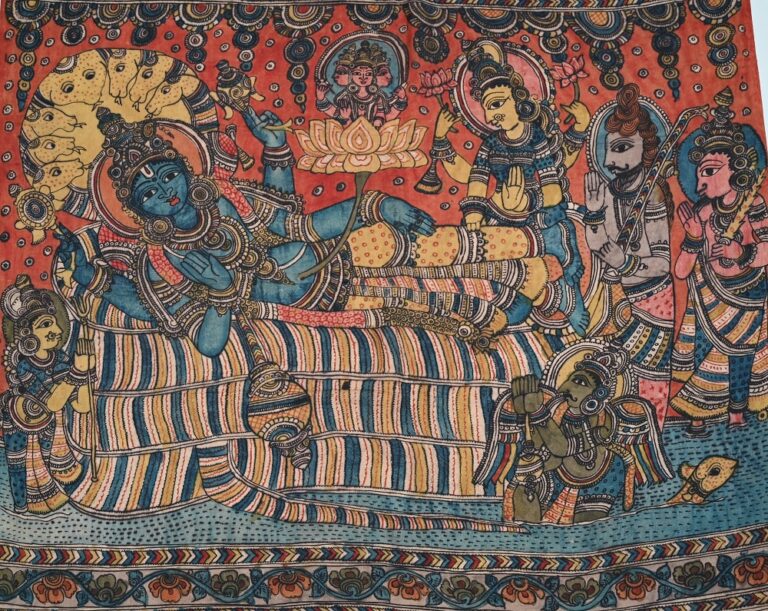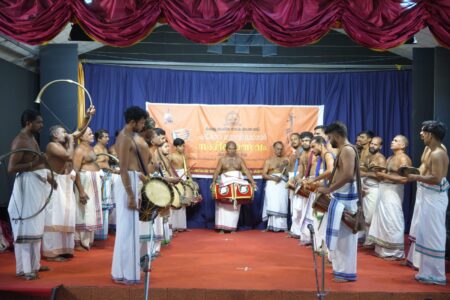Kalamkari style of textile printing – with a GI tag – may not retain its earthy lustre as chemical-dominated methods threaten the traditional art of block printing on fabric using vegetable dyes. Take a look at one arresting organic work this National Handloom Day (August 7) where free-hand drawing draws you closer.
A few years ago, four artists from the education department of the national museum of the Netherlands, the ‘Rijksmuseum’ in Amsterdam, attempted to trace the textile roots of a beautiful old collection of works called ‘sits’ (the Dutch word for Kalamkari textiles) displayed at the museum. They visited the tiny village of Pedana in the Krishna District of Andhra Pradesh to observe and learn the famed Kalamkari art from the local artisans.
According to their findings, Kalamkari artwork from this small Indian village had reached the Rijksmuseum in the 17th century. One of the artists, Irma Anne De Bruijne, who headed the arts programme at Rijksmuseum, stated, “In those days, Dutch settlers brought Kalamkari to the Netherlands from Andhra Pradesh. Kalamkari used to be expensive and exclusive as it arrived by boat. Now we aim to familiarize ourselves with the nuances of this craftsmanship, as we are passionate about promoting Kalamkari ourselves!”

Intricate hand-art
Kalamkari, which flourished throughout India from the 14th century, literally means ‘pen work,’ as it is done with a thin bamboo stick sharpened like the nib of a pen. Above this nib is a compact ball of hair that holds the liquid dye used as ink.
Kalamkari paintings done on textiles with vegetable or natural dyes gained popularity during the Muslim rule. The technique soon faded with the rise of machine-printed textiles, leaving only a minuscule number of practitioners in the Southern states of Andhra Pradesh, mainly in Srikalahasti and Machilipatnam, and in some parts of Tamil Nadu. Kalahasti, a center of pilgrimage, also showcases a devout offshoot of the craft. The temple Kalamkaris here depict narratives from Hindu mythology, explaining single episodes to entire expanses of epics, all handmade.
Collector’s pride
A huge expanse of an epic on a sari? Incredible, but that’s precisely what this collector’s piece (sari with a blouse) showcased at the textile restoration boutique, Madhurya, in South Bengaluru, is all about! “Call it a sari, wall art, or a collector’s pride; this six-yard sari speaks of a newly emerged aesthetic!” says Madhurya’s principal designer and head, Bharathy Harish, as she spreads out the sari and explains the episodes from the Mahabharata and Bhagavad Gita depicted in Kalamkari. “We handpicked it from Kalahasti during our art exploration journey after observing the nuances and educating ourselves on the intricate process involved for days together,” she added.
Is there a great demand for such drapes? “There are enough connoisseurs who know what to do with such creations, as many believe draping brings them ‘closer to the divine.’ Additionally, some fashion-cognoscenti love using them for wall displays in drawing rooms, large board rooms in corporate settings, or even at hotel receptions,” says Bharathy, emphasizing that the tradition and know-how in Kalamkari art have been passed down through generations. Their lifestyle involves listening to oral stories, folklore, and witnessing mythological dramas
Creator of the sari
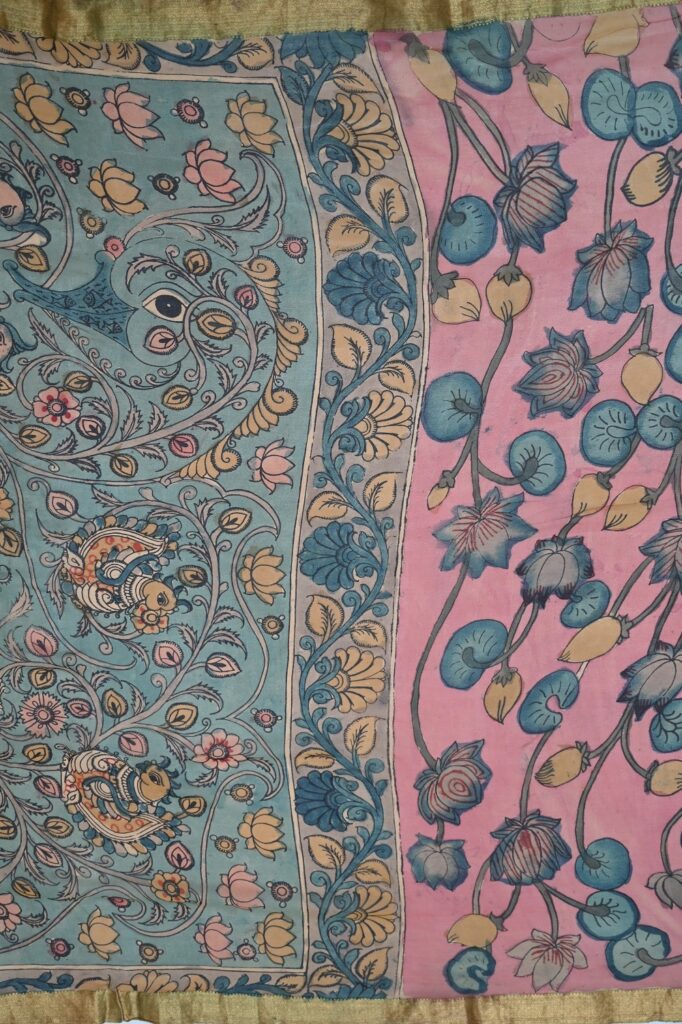
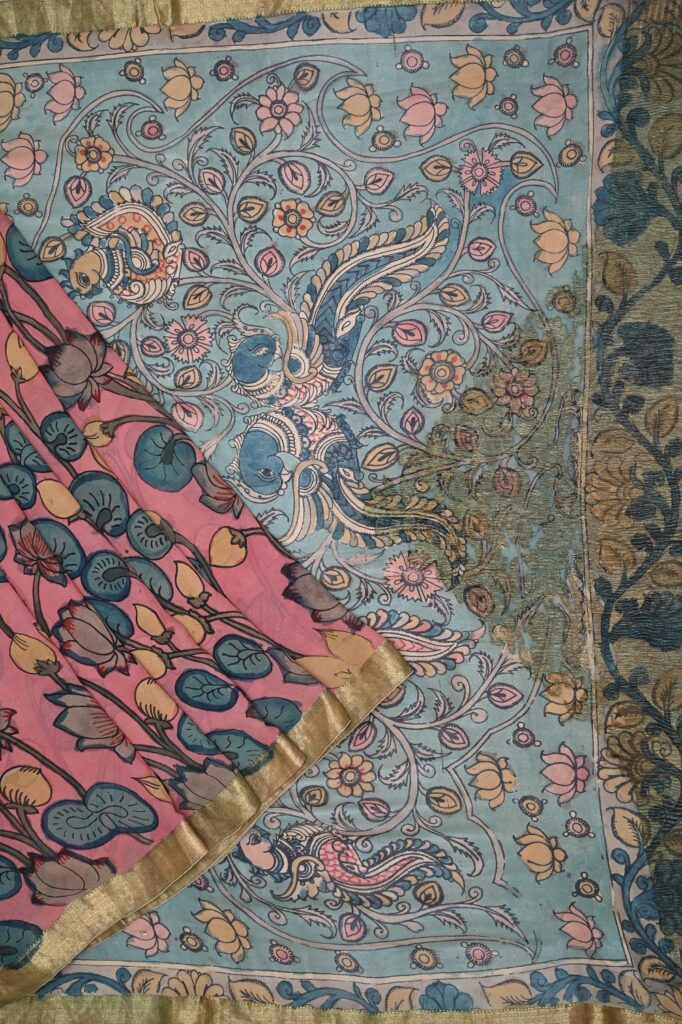
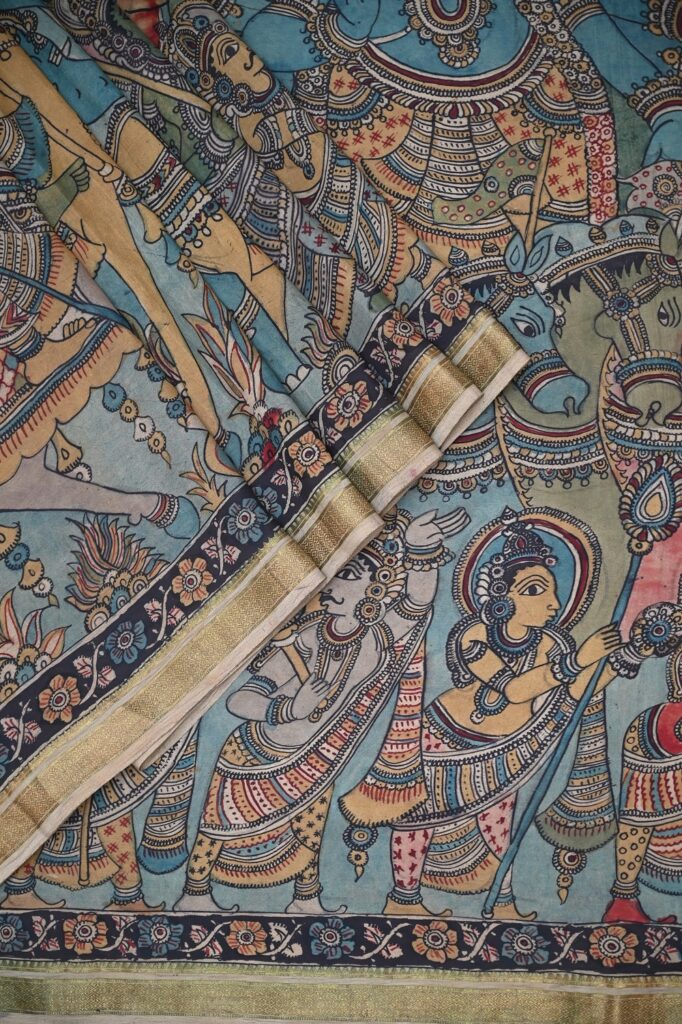
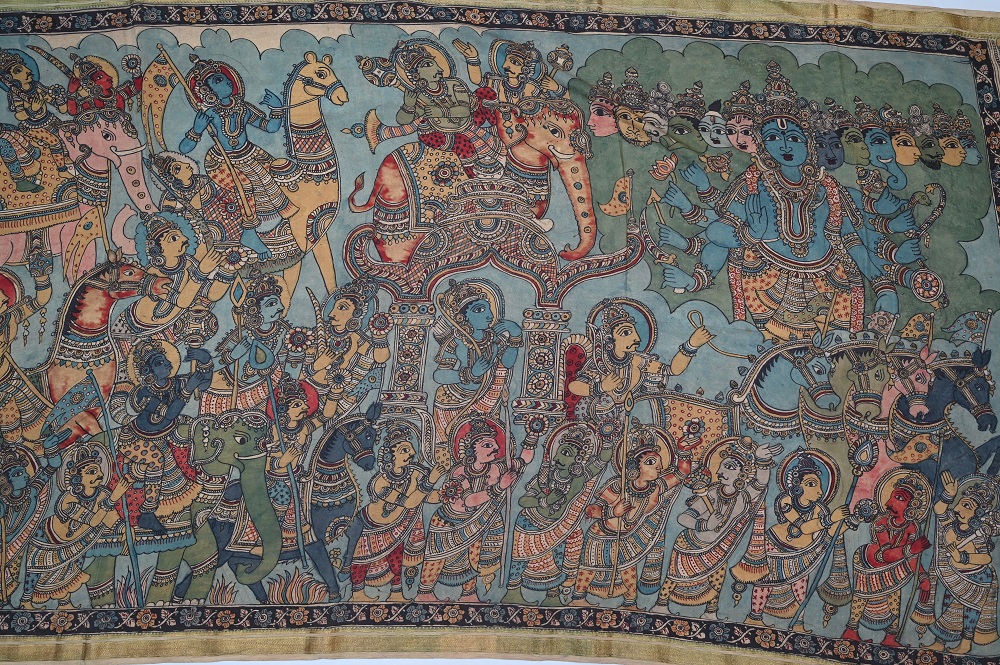
National awardee weaver Subramanyam Siddagunta of Kalahasti, who resides very near the serene Swarnamukhi river, expresses his gratification when he learns that his Kalamkari work depicting ‘Mahabharata and Bhagavad Gita’ has inspired the media to learn more about Kalamkari art. “I have been working with Kalamkari for 60 years, and I have trained nearly 3000 textile design aspirants in Government-sponsored training workshops,” says Subramanyam. He is the visionary behind the intricate detailing in the Kalamkari artwork on a sari, portraying episodes from the Bhagavad Gita, including the battlefield setting and Krishna’s discourse to Arjuna, along with His vishwaroopa darshan.
As a teenager, he was hand-picked for arts training after completing his 10th grade and received a government stipend of Rs. 30 for six months in 1964. Later, he worked for the Andhra Pradesh Handicrafts Board on daily wages for a decade.
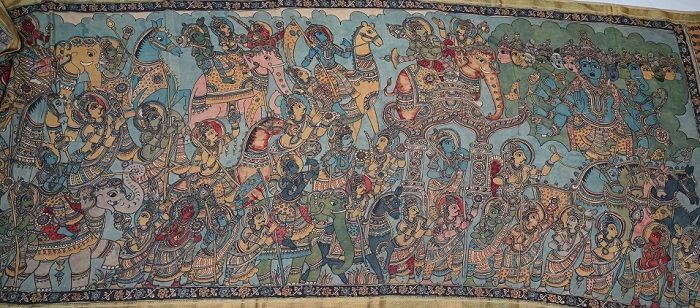
“My entire family, including my wife Sakkamma, sons Narasimhulu and Bhaskar, and my three daughters, collaborated on creating the Kalamkari sari, which involved a protracted process. After the artwork and paint, we spread the entire sari in the Swarnamukhi river in Kalahasti, where the flowing water not only washes out the extra colors, dirt, and the odor of buffalo milk and cow dung used in the art but also enriches the tints with its inherent water-minerals, making them exclusive,” says Subramanyam, emphasizing that he uses only organic, nature-friendly tints.
Long process
The fabric used for Kalamkari is first treated with a solution of cow dung and bleach to achieve a uniform off-white color. Then, it is immersed in a mixture of buffalo milk and Myrobalan seeds to prevent smudging of dyes when painted with natural colors. After a dozen washes, the fabric is dried in sunlight. Once ready, artists sketch motifs and designs on it. Subsequently, Kalamkari artists prepare dyes using natural sources to paint colors within the drawings and then take them for a river wash.
The colors come from plants, roots, leaves, and various other vegetable substances, combined with minerals like iron and mordants like alum, says Subramanyam. “The colors are muted and natural, gaining clarity with each wash,” he adds.
While the revered Srikalahasti style of Kalamkari (which has earned a GI tag) is used for garments, saris, and dupattas, it involves freehand drawing with a pen. In contrast, Machilipatnam Kalamkari uses wooden stamps to create patterns on fabric, explains Subramanyam, a recipient of the National Merit Award for his ‘Krishna Leela Story’ illustration, which he received from President VV Giri. “We perform Kalamkari on pure silk, pure cotton, chiffon, georgette, and chanderi, and the cost depends on the base material and the work done,” he says
Tackling commercial age
Like any art that goes through the highs and lows of evolving with a commercial outlook, the growing demands have brought in chemical dyes, screen printing , and digital designs and stencils that is easier instead of blocks. “It’s half the price and this inorganic Kalamkari fabric is mushrooming across India. We want the real Kalamkari to be in the limelight,” rues Subramanyam, unable to find answers.
PHOTOS – By Madhurya

